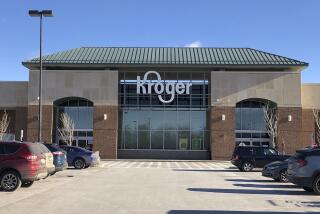Tesco may sell all Fresh & Easy stores
- Share via
British supermarket giant Tesco may soon be bidding bon voyage to its American problem child.
Five years after the company landed in California and opened 200 stores across the West, Tesco said it is preparing to sell its struggling Fresh & Easy Neighborhood Market chain and retreat from the U.S. market altogether.
“It’s likely, but not certain, that our presence in America will come to an end,” Tesco Chief Executive Philip Clarke during a Wednesday conference call from Los Angeles.
Tesco, which owns more than 6,000 stores worldwide, said it has already received inquiries from several companies interested in buying part or all the Fresh & Easy chain, or partnering with other firms to develop the business.
The announcement brought to a close a long struggle by the British retailer to establish itself in the highly competitive California grocery market. Experts said it was an ignominious end to Tesco’s once grand ambitions for its American venture, which launched in 2007 with headquarters in El Segundo.
Fresh & Easy CEO Tim Mason, a 30-year Tesco veteran, has left the company, Tesco said. “It is now clear that Fresh & Easy will not deliver acceptable shareholder returns on an appropriate time frame in its current form,” Tesco said Wednesday.
Tesco trumpeted its goal of building hundreds of smaller-format stores on the West Coast that wooed shoppers with convenience, fresh produce and tasty, prepared foods.
But in making good on those goals, the chain was plagued by problems that it never solved, analysts said. The stores have carried a limited assortment of merchandise, imported British favorites instead of adapting to American tastes, invested millions in a distribution network and commissary to make its own prepared foods.
In moving into Southern California, the chain sought to include underserved locations. Word of the company’s possible departure did not please Toyokazu Tokugawa, 51, shopping on Adams Boulevard in South Los Angeles. He says he’s a frequent shopper at Fresh & Easy because the selection and quality is better than at other local options.
“There’s no Whole Foods here, so this is good especially for the neighborhood,” said the Little Tokyo financial investor.
Analysts said a drugstore company such as Walgreen Co. or Rite Aid Corp. may scoop up the 200-store chain for the real estate. Other possible buyers include discount grocers such as German company Aldi.
Fresh & Easy never turned a profit, losing money year after year. In the first half of 2012, the supermarket chain lost about $115 million. In October, Tesco said it would cut back on investing in the chain after closing 12 locations this year. California still has 165 stores, while Nevada and Arizona have the remaining 35 locations.
On Wednesday, analysts cataloged the chain’s mishaps. Every store carries the same assortment of products no matter its location, and that assortment was wrong more often than it was right, said Jim Hertel, a managing partner at food retail consulting firm Willard Bishop.
Popular items were not swiftly restocked. The chain’s private-label products were often more expensive than their name-brand counterparts. And its pricing and promotional strategies were “head scratchers to say the least,” Hertel said.
“They were very public about how aggressive they were going to be, and it raised a set of expectations,” Hertel said. “Then the stores turned out to be less than what the hype was.”
Shoppers were also befuddled by cultural norms imported from Britain that U.S. shoppers sometimes found mystifying, said Jim Prevor, an industry analyst who edits the food retailing website PerishablePundit.
One quarter of the salad selection used to be watercress-based, which is popular in England but far less so in the U.S. The stores had no deli sections where food can be made to order, he said. Prepackaged sandwiches, commonplace to the British, often reminded U.S. shoppers of “something you get out of vending machines,” Prevor said.
Prevor said small store sizes combined with the emphasis on private-label products meant Fresh & Easy simply didn’t carry some popular labels and products.
“A typical suburban mom with two kids in the car seat isn’t coming to a 10,000-square-foot store that doesn’t sell the assortment that the kids want,” he said. “They created a concept that was neither fresh nor easy.”
It was a kind of overconfident attitude that also colored the chain’s dealings with local vendors, analysts said. When the company first landed on the West Coast, they brought a passel of British executives who adopted a “Don’t call us, we’ll call you” strategy when finding American suppliers.
“Eighteen months after they opened, people were predicting they were not going to be as successful as their aspirations,” Hertel said.
If Fresh & Easy is put on the auction block, its smaller-format stores, which average 10,000 square feet, would not tempt a traditional grocery store to bid, analysts said. But a drugstore company or a bargain supermarket chain may be interested.
Prevor doubts that Tesco will be able to find a serious buyer for a money-losing chain. “The most likely thing is they just put a lock on the door,” he said.
Not all customers were surprised by the news or disappointed.
Even though his parents live just down the block from a Fresh & Easy, Rudy Garcia, 22, said his mother does the bulk of her shopping at Food 4 Less for the better prices. A recent college graduate, Garcia said he stops by only when he needs a quick snack or a meal on the go.
“I like Fresh & Easy,” he said, “but if it went away I wouldn’t really care.”
More to Read
Inside the business of entertainment
The Wide Shot brings you news, analysis and insights on everything from streaming wars to production — and what it all means for the future.
You may occasionally receive promotional content from the Los Angeles Times.











